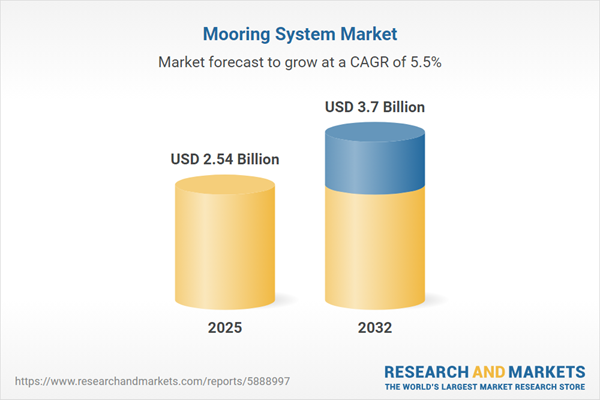Speak directly to the analyst to clarify any post sales queries you may have.
The Mooring System Market plays a pivotal role in supporting offshore and maritime projects, facilitating the precise positioning and stability of vessels and floating structures. As the sector evolves, leaders must align strategic initiatives with sector-specific requirements and emerging technology trends.
Market Snapshot: Mooring System Market Size and Growth Trajectory
The global Mooring System Market grew from USD 2.40 billion in 2024 to USD 2.54 billion in 2025 and is projected to expand at a CAGR of 5.54%, reaching USD 3.70 billion by 2032. This growth reflects rising investment across offshore wind, aquaculture, oil and gas operations, and expanding port facilities. Demand for robust mooring infrastructures is influenced by energy diversification, regulatory changes, and the increased adoption of advanced material technologies.
Scope & Segmentation: Complete Coverage of Critical Segments
- Type: Single Point Mooring, Spread Mooring, Turret Mooring (including Rotating Turret, Submerged Turret)
- Application: Aquaculture, Offshore Wind (Fixed Bottom, Floating Wind), Oil and Gas, Ports and Marinas
- Material: Chain, Synthetic Rope (Polyester, Polypropylene), Wire Rope
- Anchor Type: Drag Embedment, Driven Pile, Gravity Base, Suction Pile
- Component: Anchor, Connector (Shackles, Swivels, Terminations), Line
- Water Depth: Deep Water, Shallow Water
- Regions: Americas (North America: United States, Canada, Mexico; Latin America: Brazil, Argentina, Chile, Colombia, Peru); Europe, Middle East & Africa (United Kingdom, Germany, France, Russia, Italy, Spain, Netherlands, Sweden, Poland, Switzerland, United Arab Emirates, Saudi Arabia, Qatar, Turkey, Israel, South Africa, Nigeria, Egypt, Kenya); Asia-Pacific (China, India, Japan, Australia, South Korea, Indonesia, Thailand, Malaysia, Singapore, Taiwan)
- Leading Companies: Aker Solutions ASA, SBM Offshore N.V., TechnipFMC plc, Cargotec Corporation, Cavotec S.A., Trelleborg AB, Forum Energy Technologies, Inc., Oceaneering International, Inc., Bridon International Limited, Samson Rope Technologies, Inc.
Key Takeaways: Strategic Insights for Senior Decision-Makers
- Offshore wind farms and aquaculture expansion are accelerating the shift toward advanced and adaptive mooring solutions, requiring new deployment and design approaches.
- Digitalization, including digital twins, sensor monitoring, and predictive analytics, enables real-time system optimization and reduces lifecycle costs by improving reliability and maintenance protocols.
- Material innovation is broadening options for high-performance synthetic ropes, as companies seek lighter and more durable alternatives to traditional chain and wire systems, enhancing operational flexibility and corrosion resistance.
- Safety regulations and sustainability commitments are pushing operators to implement circular asset management practices, such as recycling and refurbishment, to reduce environmental impact and promote responsible resource use.
- Regional markets require tailored approaches, with the Americas and Asia-Pacific focusing on infrastructure expansion and resilience, while EMEA regions leverage manufacturing hubs and adopt solutions for specialized conditions.
Tariff Impact: Navigating Cost and Supply Chain Volatility
Recent United States tariffs on imported steel and synthetic rope components have produced higher material costs and encouraged manufacturers to localize production or diversify sourcing. Contract and procurement frameworks now often include cost-sharing elements to mitigate volatility. As supply chains adjust, lightweight modular anchor designs and synthetic alternatives are in growing demand for tariff resilience.
Methodology & Data Sources
This market research integrates primary interviews with engineers and operators, secondary data from regulatory sources and industry publications, and triangulation of supplier and port authority records. Each key finding is validated by subject matter experts using scenario modeling to ensure robust, actionable recommendations.
Why This Report Matters
- Provides a comprehensive breakdown of market dynamics, equipping executives with the insight needed for effective investment, product, and procurement strategies.
- Enables technical teams to benchmark current practices against leading innovations in materials, digitalization, and sustainability.
- Delivers region- and segment-specific intelligence to support strategic planning and partnership development across rapidly shifting offshore and maritime environments.
Conclusion
Stakeholders in the Mooring System Market must align operational agility with technological advancements and regulatory requirements. By drawing on these research insights, senior leaders can effectively position their organizations to deliver safe, resilient, and sustainable mooring solutions in an evolving global landscape.
Additional Product Information:
- Purchase of this report includes 1 year online access with quarterly updates.
- This report can be updated on request. Please contact our Customer Experience team using the Ask a Question widget on our website.
Table of Contents
3. Executive Summary
4. Market Overview
7. Cumulative Impact of Artificial Intelligence 2025
Companies Mentioned
The companies profiled in this Mooring System market report include:- Aker Solutions ASA
- SBM Offshore N.V.
- TechnipFMC plc
- Cargotec Corporation
- Cavotec S.A.
- Trelleborg AB
- Forum Energy Technologies, Inc.
- Oceaneering International, Inc.
- Bridon International Limited
- Samson Rope Technologies, Inc.
Table Information
| Report Attribute | Details |
|---|---|
| No. of Pages | 199 |
| Published | November 2025 |
| Forecast Period | 2025 - 2032 |
| Estimated Market Value ( USD | $ 2.54 Billion |
| Forecasted Market Value ( USD | $ 3.7 Billion |
| Compound Annual Growth Rate | 5.5% |
| Regions Covered | Global |
| No. of Companies Mentioned | 11 |









